Eldraine Check, Part 1
It's time to start sharing some card-by-card design stories from Throne of Eldraine. I have a lot of fun stories, so let's just get started.
Bake into a Pie
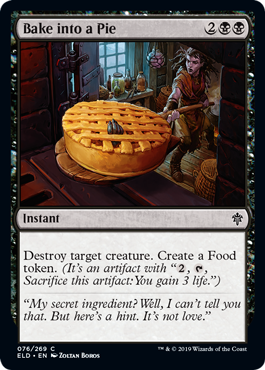
Interestingly, this card started not as a black card, but as a white one:
Bake into Pie (uncommon)
2W
Enchantment — Aura
Enchant Creature
Enchanted creature is a colorless artifact named Pie, has "Sacrifice this artifact: You gain 2 life," and loses all other card types and abilities.
This was one of the earliest cards added to the file and was basically a Pacifism/Arrest variant. The flavor was you'd baked your opponent's creature into a pie, so the opponent could use it to gain life if they wanted to "eat" it. My best guess is that this card was one of the things that led Set Design down the path toward Food tokens. Once they did, the cleaner version of the card was just destroying the creature and giving its controller a Food token. That ability felt less like a Pacifism variant, though, and more like a kill spell, so the ability was moved to black—but of course, the name was kept as that was the impetus for the design in the first place.
Bartered Cow
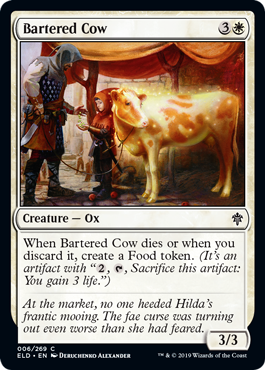
Here's how this card started out:
Tradeable Cow (uncommon)
2R
Creature — Cow
When CARDNAME enters the battlefield, exchange it with a nonland permanent controlled by target opponent of their choice.
2/2
Inspired by "Jack and the Beanstalk," this card would always lead you to trading your cow, but it wouldn't always lead to the best of trades. At the same time I designed this card, I also made an artifact called Magic Beans (I think you sacrificed it to make a Beanstalk Wall), so every once in a while, the Cow would get traded for the Magic Beans. I loved the idea that the Cow would also get traded for other things and you got to create a story about how that trade did or did not help you.
I put the Cow in red because the trading was a red ability (or blue, but a Cow seemed more red than blue), but a domesticated Cow is much more of a white thing. Set Design would kill my card (note that it went through a number of changes in vision design) and make a new Cow in white, one that cutely tied into Food tokens. I'm happy that the Cow is in the set as it allows a fun mixing and matching of fairy-tale components in gameplay, but I'm sad that you will seldom get to trade it (although, technically, you can if Oko forces two players to do so).
Beanstalk Giant

Here's our first attempt at making the Beanstalk Giant (which came about a little later in vision design):
Beanstalk (common)
2G
Creature — Plant
Defender
4GG, Sacrifice CARDNAME: Create a 6/6 green Giant.
0/4
Our first take on capturing the giant from "Jack and the Beanstalk" was to have a Beanstalk Wall that late-game got you the Giant. I believe that's the version that got handed off to Set Design. When they were making the Adventure cards, they realized there was a cool card to make where the spell fetched land and the creature had power and toughness equal to the number of lands you had. I think the card got designed first and when looking for how to flavor it, they came across the idea of making it the Beanstalk Giant, but it's possible the idea came out of making an Adventure card for the Giant.
Blow Your House Down
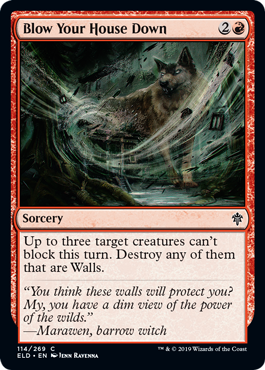
One of the ways to do top-down design is to start with a name. Blow Your House Down felt like a card name we wouldn't be using anywhere else, but was a great fit in Throne of Eldraine. The big question was what should "Blow Your House Down" do? Obviously, it needed to destroy houses, but what exactly does that mean in gameplay terms? After some thought, the idea was that it could destroy Walls. Houses have walls after all. (We just had to remember not to make a Wall of Bricks in the set.)
While Tunnel was a card in Limited Edition (Alpha), destroying a Wall is a little bit narrow these days to build a whole card around. Okay, Wall destruction has typically been red—was there any secondary effect we could tie to Wall destruction, also in red? Ideally, we wanted something that was functional, even if the opponent didn't have a Wall, as most of the time they wouldn't. One of the effects we do most sets, usually in common, is what R&D calls a "Panic" effect (aka a spell that keeps some number of creatures from blocking; the nickname comes from an early card that did this effect).
Normally, Panic effects will affect two, three, or all the creatures. We're playing around here with the story of The Three Little Pigs, so three would add a little extra aesthetic to the design. (You'll notice we do this a bit in the set as fairy tales often have iconic numbers tied to them.) The last step was to tie the two effects together. Rather than have some creatures not block and some Walls destroyed, the effect just picks up to three target creatures and applies both effects—you can't block and are destroyed if you're a Wall. And that's how you can destroy Wall of Sticks and Wall of Straw. (Yes, we talked about such cards, but didn't have room for them.)
The Castles
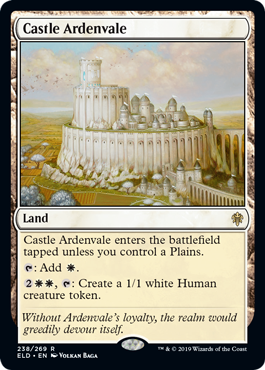
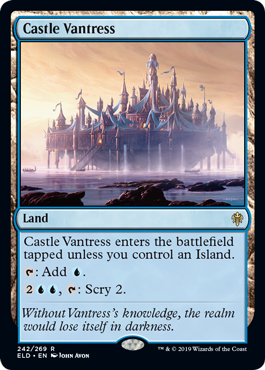
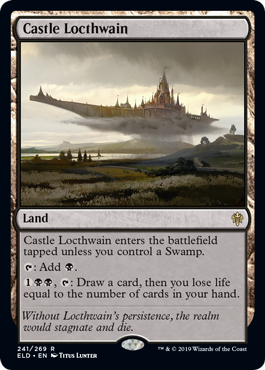
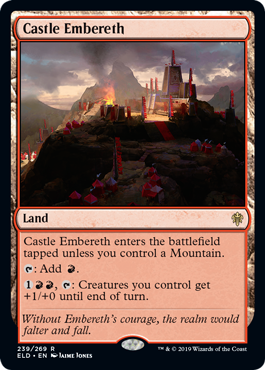
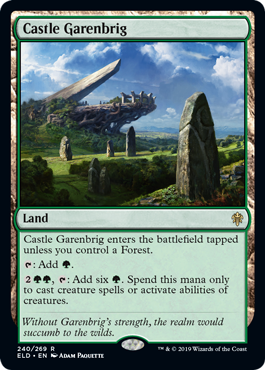
As Throne of Eldraine had a monocolor focus, we made the decision not to put dual lands in the set. (Fear not, dual land fans, there are more coming in later sets.) The idea was to make a rare cycle of monocolor lands that represented the castles of the five courts. We wanted each of the lands to tap for its color of mana, but we didn't want to just have them enter the battlefield tapped as that's the restriction we usually have to do with lands producing colored mana. After experimenting with various restrictions, we ended up using "enters tapped unless you control a [basic land that produces the associated color mana]." We felt in a monocolor deck, this would be easy to do, and in a two-color deck, it would be manageable.
We then gave each land a good activated ability, one that played into the theme of that court. White, the court of loyalty, gets to create creatures to build up its large, faithful army. Blue, the court of knowledge, gets the ability to look into the future to improve your draw. Black, the color of persistence, gets to trade life for cards. Red, the court of courage, gets to pump its team. Green, the court of strength, gets mana to cast and activate its larger creatures. We made each ability require two colored mana to make sure that the cards were strongest in monocolor decks.
Charmed Sleep
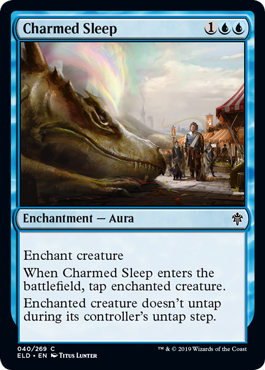
When designing top-down sets, much of the design has to be created from scratch, but not all of it. One of the things you do is to look through past Magic cards that mechanically match the feel of a trope, even if it doesn't have the right name. Then you just change the name and, voila, you have a top-down design. That's exactly what happened here. We were trying to figure out how to do a sleep spell (a classic piece of fairy-tale magic), and it dawned on us that it was the spell Claustrophobia. We didn't need to reinvent the wheel, we just needed to give it a new name. We created this card in the first few weeks of vision design, and it never changed. The set needed a blue common lockdown creature answer for Limited, so the card had to be there anyway. Tying it so tightly to a trope was pure upside.
Charming Prince
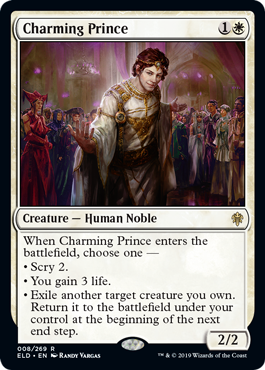
Charming Prince was one of the earliest additions to the file. We knew we wanted to do a Prince Charming–like card, and I came up with the idea early on to play off the word "charming" in that it would have an "enters the battlefield" charm effect. (A charm effect is usually a cheaper modal spell that has three small effects to choose from. The charms first appeared in Mirage and have been done numerous times since.) I called it Charming Prince, and here was my original design:
Charming Prince (uncommon)
2W
Creature — Human Noble
When CARDNAME enters the battlefield, choose one:
• Destroy target enchantment.
• Put a +1/+1 counter on another creature you control.
• Gain 4 life.
2/2
I chose the effects very carefully. First, we had already designed Charmed Sleep, and, of course, the Charming Prince had to be able to wake up a sleeping princess. He could invite you to the ball, which would pump you up with excitement and thus a +1/+1 counter. Or he could marry you and you could live happily ever after—life gain being one of the ways we show happiness, as it makes you, the player, stronger. Note we were also experimenting with using the Noble creature type as we felt we wanted a way to represent being a ruler of some kind. The set wanted a bunch of kings, queens, princes, and princesses. I was in love with this design. It was elegant and flavorful. And then this happened:
Guilds of Ravnica was looking for a tournament-competitive Selesnya creature, and Set Design created this card. I tried my best to see if I could help redesign it to keep it off of Charming Prince, but too many pieces were needed to make it work in tournaments. That meant that Charming Prince was going to be the one to change. This all happened late in vision design, so I asked Set Design to keep the name and the "enters the battlefield" charm structure. It would also be great if it could help out creatures trapped by things like Charmed Sleep.
Set Design messed around with many different effects. I believe the flicker effect (the last effect that temporarily exiles a creature) was added to be the thing that helps the prince wake up creatures in distress. He was able to keep the life-gain effect, although for 1 less life. I believe the scry 2 effect played well and allowed the prince to help you out by giving you a little knowledge of what's soon to come.
The other story about this card was that when the creature got an official name, it was changed away from Charming Prince. I think it was Royal Charmer. They were trying to keep the nod toward Prince Charming and to get the word "charm" into the title. The cosmology of the world was moving it away from technically being a prince storywise. So, I went and begged Jenna, who was in charge of the names. I told her it was my favorite name in the whole set. Part of what was going to make Throne of Eldraine shine was a lot of the cuteness of the execution of how we handled the fairy-tale tropes. Royal Charmer wasn't a bad name, but it wasn't Charming Prince. She saw my point and changed it. For all those who follow me on my blog, this was the "punny" name I said I was so proud of.
Clackbridge Troll
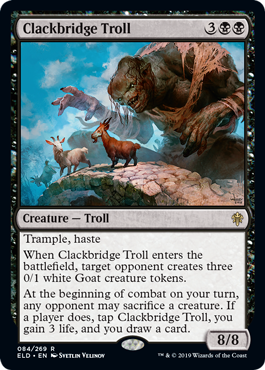
One of the challenges of doing top-down designs for fairy tales was that there are certain themes repeating throughout many tales. For example, there are a lot of groups that come in three. There are the Three Bears, the Three Little Pigs, and the Three Billy Goats Gruff. Each of them shows up in Throne of Eldraine, each creating three creature tokens (Flaxen Intruder and Wolf's Quarry are the other two cards). The trick was making them stand apart from one another. The Bears are 2/2s, the Pigs (Boars in Magic-ese) are 1/1s, and the Goats are 0/1s.
To further differentiate the Goats from the Bears and Pigs, they were made white and given away to the opponent. The idea is that the card itself represents the troll (who lives under the bridge—you can see the bridge in the art), and each turn he demands to be fed or else he's going to attack you, and as an 8/8 trampler, he's kind of scary. The Goat tokens are a way to help your opponent slow down the Troll. Even when they're used, you, as the owner of the Troll, still do okay, as you gain 3 life (thanks to the yummy creature) and get to draw a card (apparently holding bridges for ransom teaches you some life lessons).
Interestingly, the card started out in a very different place. Here's the original design:
Bridge Troll (uncommon)
3B
Creature — Troll
Creatures can't attack you or a planeswalker you control unless their controller pays 1 life for each creature he or she controls that's attacking.
2/2
The first design focused more on just the Troll and it being a thing that slows down movement. What we found was not enough players were getting that this was the troll from "Three Billy Goats Gruff," so we changed the design to incorporate the Goats.
Crystal Slipper
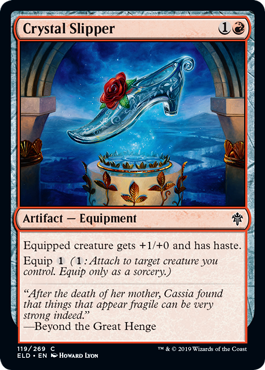
One of the first items we wrote down on the list of tropes was Glass Slipper. There are few fairy-tale items more iconic. The big question was what did it do? In the story, it doesn't have any magical qualities and is more known for being left behind than anything else. As it was footwear, it felt like it had to be Equipment. All the footwear since the introduction of Equipment has been Equipment (although, we do a surprisingly little amount of it). We experimented with Equipment that occasionally falls off, but it was being defined more by how it fails. In the end, we decided to just treat it like magical footwear, having it grant a power boost and speed. In Throne of Eldraine, Cinderella is pretty fast.
Curious Pair
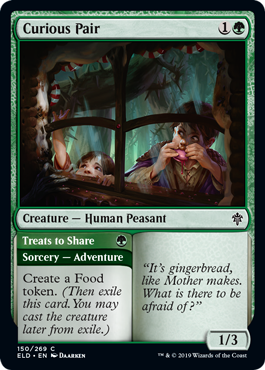
"Hansel and Gretel" was another fairy tale that had a lot of elements to play around with. You'll notice there are numerous cards in the set that reference the story (Gingerbread Cabin, Trail of Crumbs, and Witch's Oven). For the siblings themselves, we ended up using an Adventure card. We wanted a cheap common that let you cast a spell turn one and play the creature turn two. Hansel and Gretel are just two small kids, so they seemed okay as a two-drop. The one-drop was obvious as the two are starving and looking for food. So, you play some Food, and look who shows up the following turn?
Emry, Lurker of the Loch
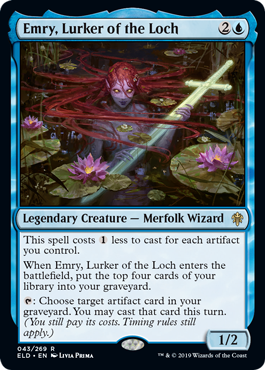
I've been talking a lot about fairy-tale tropes, but this set also got to play with Arthurian legend tropes. For example, the Lady of the Lake was the character that gave Excalibur to Arthur (a lot of people falsely think the sword Arthur pulls out of the stone to become king is Excalibur, but it's not; for some reasons, there are two different swords—we combined them into one as only the true diehard fans of the story know that there isn't just one sword). In the actual legend, the Lady of the Lake was an enchantress and didn't actually live in the lake, but we're doing a Magic twist on it, and it seemed fun to make our version actually live in the lake, and, thus, be a Merfolk.
Because her defining quality was the granting of Excalibur, we made her a creature that can cast artifacts out of your graveyard. (Blue can put artifacts in the graveyard into your hand, but we thought it was fun to give her a twist.) We added the mill "enters the battlefield" effect to help you get a few artifacts into your graveyard. We also allowed her to have a spell reduction based on how many artifacts you have on the battlefield. The total package was meant to create a card that you can build an artifact deck around.
The last story about this card is that I wanted it to be called Lady of the Loch. As a fan of wordplay, I thought it made a clean nod to the source material while also acknowledging that we were doing the story a smidgen differently. While I was successful in getting Charming Prince's name, I was unsuccessful here.
Enchanted Carriage
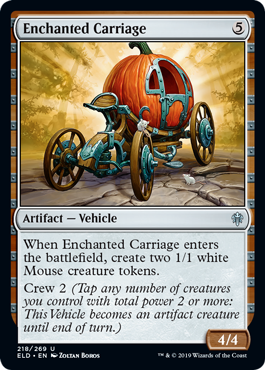
One of the things you do when creating a top-down design is to think of all the different types of Magic cards and then ask, what in the source material does that? For example, Magic has Vehicles. That forced us to ask, between fairy tales and Camelot, what are the most memorable Vehicles? The most obvious answer was Cinderella's enchanted carriage made from a pumpkin through magic.
Here was our first shot at the design:
Magical Carriage (uncommon)
2
Artifact — Vehicle
Crew 2 CARDNAME can only be crewed by creatures with power 1.
5/5
Obviously, we could show in the art that it was made out of a pumpkin, but was there any other way mechanically to play up that this was Cinderella's enchanted carriage? Our first take was to nod that it was pulled by magically altered mice, restricting the crewing to just small creatures (flavored by power 1 or less). The restriction allowed us to make very exciting looking numbers—two mana for a 5/5, but it turned out to be very hard to actually pull off.
The answer to the design was to drop the crewing restriction and have the Vehicle create two white Mouse creature tokens that were just enough to crew the Vehicle. We had to change the numbers around, but the flavor was great. All was good until we were informed that Magic doesn't have any Mouse creature tokens. We normally use Rat, and those have always been black. Two black Rat creature tokens lost the whole feel of the card, so the Set Design team pushed for adding white Mouse creature tokens to Magic. Obviously, they were successful.
So Many Tales to Tell
That's all the time I have for today. I hope you're enjoying all the stories. As always, I'm eager to hear your thoughts on today's column or Throne of Eldraine in general. You can email me or contact me through any of my social media accounts (Twitter, Tumblr, and Instagram).
Join me next week when I'll continue telling more card-by-card design stories.
Until then, may your games end happily ever after.
#673: Banned & Restricted, Part 4
#673: Banned & Restricted, Part 4
This is part four of a four-part series on all the banned or restricted cards I had a hand in designing.
#674: SDCC 2019
#674: SDCC 2019
33:39
As is normal, I went to San Diego Comic-Con, but this year, I got to reveal Throne of Eldraine to the world. It was quite fun. In this podcast, I fill you in on my entire trip.
- Episode 672 Banned & Restricted, Part 3
- Episode 671 Banned & Restricted, Part 2
- Episode 670 Banned & Restricted, Part 1

